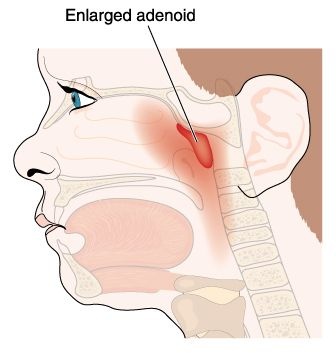Mark Kopec Now
Adenoidectomy
Adenoids are small clumps of lymphatic tissue located in the upper part of the throat behind the soft palate. They play a role in the immune system, helping to trap bacteria and viruses entering through the nose. Particularly in children, adenoids are relatively large and shrink naturally as we become adults. However, sometimes these adenoids become too large, causing a variety of problems that can require their removal through a surgery called an adenoidectomy. If an adenoidectomy has left you injured, then call Baltimore adenoidectomy lawyer Mark Kopec at the Kopec Law Firm.
Anatomy and Symptoms of Enlarged Adenoids
Adenoids are in the nasopharynx, the area where the nasal cavity meets the upper part of the throat. When they become too large, they can block the airway, leading to:

- Chronic nasal congestion or stuffy nose
- Mouth breathing, especially during sleep (sleep apnea)
- Snoring
- Frequent ear infections
- Difficulty swallowing (Dysphagia)
- Facial pain
- Changes in voice quality (nasal voice)
- Sleep disturbances
Baltimore adenoidectomy lawyer Mark Kopec at the Kopec Law Firm can review your medical history with you as part of the free consultation.
Consulting the Doctor and Diagnosis
If you suspect adenoids become too large, particularly in your child, it’s crucial to consult an otolaryngologist (ENT), a doctor specializing in ear, nose, and throat conditions. The ENT will then conduct a physical examination, looking for visible signs that the adenoids are too large. The doctor will also check the nasal passages using a lighted instrument.
Several tests might be used to aid diagnosis:
- Nasopharyngoscopy: A thin, flexible tube with a light and camera is inserted through the nose to directly visualize the adenoids.
- X-ray or CT scan: While not always necessary, these imaging tests can provide a detailed view of the nasopharynx and surrounding structures, helping to confirm enlarged adenoids or rule out other causes for the symptoms.
- Allergy testing: If allergies are suspected to be contributing to adenoid enlargement, allergy testing may be performed.
Treatment Options
The primary treatment for enlarged adenoids is watchful waiting, especially in young children. As they grow, adenoids naturally shrink in most cases. However, if symptoms are persistent and cause significant problems like sleep apnea or frequent infections, an adenoidectomy may be recommended.
Other treatment options, depending on the cause, might include:
- Medications: Antihistamines can help manage allergy symptoms. Antibiotics may be prescribed for recurrent bacterial infections.
- Nasal corticosteroids: Steroid sprays can help reduce inflammation in the nose and adenoids.
Baltimore adenoidectomy lawyer Mark Kopec can discuss with you the treatment options that the doctor offered you.
The Adenoidectomy Procedure
The doctor typically performs an adenoidectomy as an outpatient procedure, meaning the patient goes home the same day. The surgeon usually does it under general anesthesia, ensuring the patient is asleep and feels no pain.
During the surgery:
- The surgeon inserts a small instrument to keep the mouth open.
- The surgeon also uses special tools to remove the adenoid tissue. This may involve curettes (instruments shaped like a spoon), electrosurgery, or radiofrequency ablation.
- The procedure is typically quick, lasting about 30 minutes.
Risks and Complications & the Need for Baltimore Adenoidectomy Lawyer Mark Kopec
Adenoidectomy carries some risks and potential complications. These include:
- Bleeding
- Infection
- Difficulty swallowing
- Voice changes
- Nasal discharge
- Injury to surrounding structures
Medical Malpractice Claims with Baltimore Adenoidectomy Lawyer Mark Kopec
Medical malpractice related to adenoidectomy can occur. Examples include:
- Failure to diagnose or misdiagnosis of enlarged adenoids: If a healthcare professional misses clear signs of enlarged adenoids and delays necessary treatment, then you may have a medical malpractice claim.
- Surgical errors: Damage to surrounding structures during surgery due to negligence could be grounds for a malpractice claim.
- Anesthesia errors: Mistakes during anesthesia administration can lead to serious complications.
Enlarged adenoids can cause a variety of problems, particularly in children. While watching and waiting is often the initial approach, an adenoidectomy may be necessary if symptoms are severe or continue. If you experience any unexpected or concerning issues following an adenoidectomy, consult your doctor immediately. Additionally, if you believe medical negligence resulted in harm during the procedure, seeking legal counsel might be necessary.
Next Step – Contact Baltimore Adenoidectomy Lawyer Mark Kopec
Visit our free consultation page or video. Then contact the Kopec Law Firm at 800-604-0704 to speak directly with Attorney Mark Kopec. He is a top-rated Baltimore medical malpractice lawyer. The Kopec Law Firm is in Baltimore and pursues cases throughout Maryland and Washington, D.C.





